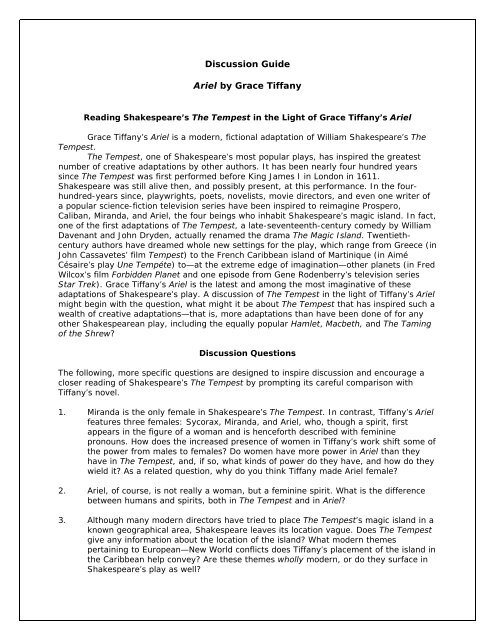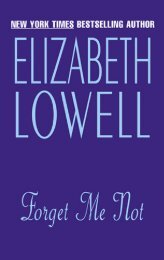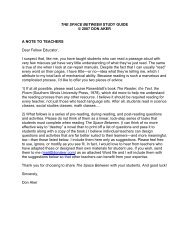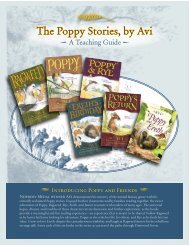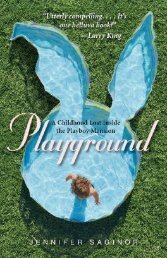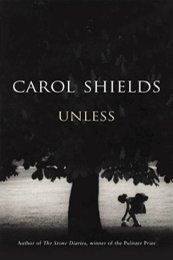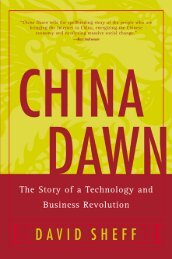Discussion Guide Ariel by Grace Tiffany
Discussion Guide Ariel by Grace Tiffany
Discussion Guide Ariel by Grace Tiffany
You also want an ePaper? Increase the reach of your titles
YUMPU automatically turns print PDFs into web optimized ePapers that Google loves.
<strong>Discussion</strong> <strong>Guide</strong><br />
<strong>Ariel</strong> <strong>by</strong> <strong>Grace</strong> <strong>Tiffany</strong><br />
Reading Shakespeare’s The Tempest in the Light of <strong>Grace</strong> <strong>Tiffany</strong>’s <strong>Ariel</strong><br />
<strong>Grace</strong> <strong>Tiffany</strong>’s <strong>Ariel</strong> is a modern, fictional adaptation of William Shakespeare’s The<br />
Tempest.<br />
The Tempest, one of Shakespeare’s most popular plays, has inspired the greatest<br />
number of creative adaptations <strong>by</strong> other authors. It has been nearly four hundred years<br />
since The Tempest was first performed before King James I in London in 1611.<br />
Shakespeare was still alive then, and possibly present, at this performance. In the fourhundred-years<br />
since, playwrights, poets, novelists, movie directors, and even one writer of<br />
a popular science-fiction television series have been inspired to reimagine Prospero,<br />
Caliban, Miranda, and <strong>Ariel</strong>, the four beings who inhabit Shakespeare’s magic island. In fact,<br />
one of the first adaptations of The Tempest, a late-seventeenth-century comedy <strong>by</strong> William<br />
Davenant and John Dryden, actually renamed the drama The Magic Island. Twentiethcentury<br />
authors have dreamed whole new settings for the play, which range from Greece (in<br />
John Cassavetes’ film Tempest) to the French Caribbean island of Martinique (in Aimé<br />
Césaire’s play Une Tempéte) to—at the extreme edge of imagination—other planets (in Fred<br />
Wilcox’s film Forbidden Planet and one episode from Gene Rodenberry’s television series<br />
Star Trek). <strong>Grace</strong> <strong>Tiffany</strong>’s <strong>Ariel</strong> is the latest and among the most imaginative of these<br />
adaptations of Shakespeare’s play. A discussion of The Tempest in the light of <strong>Tiffany</strong>’s <strong>Ariel</strong><br />
might begin with the question, what might it be about The Tempest that has inspired such a<br />
wealth of creative adaptations—that is, more adaptations than have been done of for any<br />
other Shakespearean play, including the equally popular Hamlet, Macbeth, and The Taming<br />
of the Shrew?<br />
<strong>Discussion</strong> Questions<br />
The following, more specific questions are designed to inspire discussion and encourage a<br />
closer reading of Shakespeare’s The Tempest <strong>by</strong> prompting its careful comparison with<br />
<strong>Tiffany</strong>’s novel.<br />
1. Miranda is the only female in Shakespeare’s The Tempest. In contrast, <strong>Tiffany</strong>’s <strong>Ariel</strong><br />
features three females: Sycorax, Miranda, and <strong>Ariel</strong>, who, though a spirit, first<br />
appears in the figure of a woman and is henceforth described with feminine<br />
pronouns. How does the increased presence of women in <strong>Tiffany</strong>’s work shift some of<br />
the power from males to females? Do women have more power in <strong>Ariel</strong> than they<br />
have in The Tempest, and, if so, what kinds of power do they have, and how do they<br />
wield it? As a related question, why do you think <strong>Tiffany</strong> made <strong>Ariel</strong> female?<br />
2. <strong>Ariel</strong>, of course, is not really a woman, but a feminine spirit. What is the difference<br />
between humans and spirits, both in The Tempest and in <strong>Ariel</strong>?<br />
3. Although many modern directors have tried to place The Tempest’s magic island in a<br />
known geographical area, Shakespeare leaves its location vague. Does The Tempest<br />
give any information about the location of the island? What modern themes<br />
pertaining to European—New World conflicts does <strong>Tiffany</strong>’s placement of the island in<br />
the Caribbean help convey? Are these themes wholly modern, or do they surface in<br />
Shakespeare’s play as well?
4. Working in the different mediums of stage-play and novel, both Shakespeare and<br />
<strong>Tiffany</strong> try ceaselessly to convey the sense that this island is surrounded <strong>by</strong> water.<br />
How does Shakespeare make sure his audience never forgets that the sea surrounds<br />
the island? (This, <strong>by</strong> the way, is no mean feat when his actors stand on a bare, landlocked<br />
stage which lacks scenic backdrops and a modern sound system!) Does<br />
<strong>Tiffany</strong> successfully create and maintain a similar sense of vast water around the<br />
island, and, if so, how does she do so?<br />
5. As a question related to question 4, how does water come into our lives? What do<br />
watery things signify in terms of human experience? (Students are encouraged to<br />
think of rain, solid or melting ice, sailing, drinking, birth—when “water breaks”—<br />
swimming, baptism, dissolving, weeping.) How do those “watery” experiences figure<br />
in The Tempest and in <strong>Ariel</strong>?<br />
6. And, relative to questions 4 and 5, in The Tempest, when King Alonso asks Prospero,<br />
“When did you lose your daughter?” Prospero replies “In this last tempest.” However,<br />
we know that it is Alonso who has lost his son Ferdinand in “this last tempest”<br />
(5.1.152-153), 1 while Prospero has not lost his daughter at all in a physical sense.<br />
How does <strong>Tiffany</strong>’s description of Miranda’s first sight of Ferdinand on pp. 170-171,<br />
beginning “She was at sea,” comment on and attempt to interpret Prospero’s odd<br />
comment to Alonso in act five, scene one, of Shakespeare’s play?<br />
7. Compare Shakespeare’s Caliban to <strong>Tiffany</strong>’s Caliban. Are they entirely different, or<br />
does <strong>Tiffany</strong> truly appear to be basing her character on Shakespeare’s? Find at least<br />
one specific passage or interchange of dialogue in Shakespeare’s The Tempest that<br />
might support <strong>Tiffany</strong>’s interpretation of Caliban.<br />
8. Is <strong>Tiffany</strong>’s Miranda anything like Shakespeare’s? Again, find passages in<br />
Shakespeare that either justify or cast doubt on <strong>Tiffany</strong>’s version of Miranda.<br />
Do the same with any of the other characters <strong>Tiffany</strong> represents.<br />
9. In act five, scene one, of Shakespeare’s The Tempest, <strong>Ariel</strong> tells Prospero that his<br />
enemies Alonso and Antonio are now Prospero’s prisoners, and says, “[I]f you now<br />
beheld them, your affections/ Would become tender” (ll. 18-19). Prospero responds,<br />
“Hast thou, which art but air, a touch, a feeling/ Of their afflictions, and shall not<br />
myself,/ One of their kind, that relish all as sharply,/ . . . be kindlier moved than<br />
thou art?” (ll. 21-24). He concludes that he will forgive them. Compare Prospero’s<br />
and <strong>Ariel</strong>’s interchange to that described <strong>by</strong> <strong>Tiffany</strong> on pp. 181-183 and pp. 202-205<br />
of <strong>Tiffany</strong>’s novel. What is the difference between the influence Shakespeare’s <strong>Ariel</strong><br />
has on Shakespeare’s Prospero and the influence <strong>Tiffany</strong>’s <strong>Ariel</strong> has on <strong>Tiffany</strong>’s<br />
Prospero?<br />
10. What is Shakespeare’s <strong>Ariel</strong>? What is <strong>Tiffany</strong>’s <strong>Ariel</strong>? Do they represent different<br />
things? Or do they represent the same thing, and Shakespeare and <strong>Tiffany</strong> disagree<br />
about this thing’s worth?<br />
11. Does <strong>Tiffany</strong>’s final chapter—her epilogue—go way beyond any implications of<br />
European—New World encounter suggested in the original The Tempest? Or do the<br />
ideas proposed in this final chapter take their root from something in Shakespeare’s<br />
play?<br />
1 William Shakespeare, The Tempest, ed. Sylvan Barnet, NY: Signet, 1998.
12. What are some of the relevant distinctions between the genres of novel and play that<br />
these two works invite us to observe? What can <strong>Tiffany</strong> do in her fiction, because of<br />
the difference in the medium, that Shakespeare cannot do on the stage? Conversely,<br />
what can Shakespeare create and achieve with his live actors on a stage that <strong>Tiffany</strong><br />
cannot do in her fiction?<br />
Final questions might be: Should authors take the kind of license that <strong>Tiffany</strong> has taken with<br />
Shakespeare? Why? Why not? Does her book help us understand Shakespeare? Does<br />
Shakespeare help us understand her book?<br />
Performance Exercise<br />
Enact a scene or portion of a scene from The Tempest, then read aloud or dramatize<br />
(casting a narrator and speaking characters) the section of <strong>Ariel</strong> that seems to be based on<br />
that scene. Discuss the differences in theme and character that this way become evident.<br />
Some possible scene comparisons:<br />
Act one, scene one, of The Tempest and pages 159-161 of <strong>Ariel</strong><br />
Act one, scene two, lines 24-168 of The Tempest and pages 186-191 of <strong>Ariel</strong><br />
Act one, scene two, lines 314-374 of The Tempest and pages 136-138 of <strong>Ariel</strong><br />
Act one, scene two, lines 237-304 of The Tempest and pages 112-114 of <strong>Ariel</strong><br />
Act one, scene two, lines 397-503 of The Tempest and pages 167-174 of <strong>Ariel</strong><br />
Act two, scene one, line 148-331 of The Tempest and pages 176-183 of <strong>Ariel</strong><br />
Act four, scene one, lines 60-145 of The Tempest and pages 196-200 of <strong>Ariel</strong><br />
Suggested additional reading:<br />
W. H. Auden, “Prospero to <strong>Ariel</strong>,” from The Sea and the Mirror, excerpted in W. H. Auden:<br />
Selected Poems, ed. Edward Mendelson, NY: Vintage, 1979, pp. 129-135<br />
<strong>Ariel</strong><br />
By <strong>Grace</strong> <strong>Tiffany</strong><br />
Tr 0-06-075327-7 • $16.99 ($22.99)<br />
Lb 0-06-075328-5 • $17.89 ($23.89)<br />
Laura Geringer Books<br />
An Imprint of HarperCollinsPublishers<br />
www.harperchildrens.com<br />
For exclusive information on your favorite authors and artists, visit www.authortracker.com.


